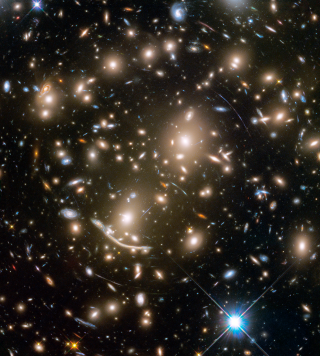Bibcode
Acosta-Pulido, J. A.; Agudo, I.; Barrena, R.; Ramos-Almeida, C.; Manchado, A.; Rodríguez-Gil, P.
Bibliographical reference
Astronomy and Astrophysics, Volume 519, id.A5
Advertised on:
9
2010
Journal
Citations
15
Refereed citations
13
Description
Context. NRAO 150 is one of the brightest radio and mm AGN sources in
the northern sky, and is an interesting source to study extreme
relativistic jet phenomena. However, its cosmological distance has not
yet been calibrated, because of its optical faintness due to strong
Galactic extinction. Aims: We measure the redshift of NRAO 150,
to enable us to perform quantitative studies of the source.
Methods: We conducted spectroscopic and photometric observations of the
source in both the near-IR and the optical. Results: All these
observations were successful in detecting the source. The near-IR
spectroscopic observations exhibit strong Hα and Hβ emission
lines from which the cosmological redshift of NRAO 150 (z = 1.517
± 0.002) is determined for the first time. We classify the source
as a flat-spectrum radio-loud quasar, for which we estimate a high
supermassive black-hole mass ~5 × 109 M_&sun;. After
extinction correction, the new near-IR and optical data show a
high-luminosity continuum-emission excess in the optical (peaking in the
rest frame at ~2000 Å) that we attribute to thermal emission from
the accretion disk for which we estimate a high accretion rate of ~30%
the Eddington limit. Conclusions: Comparison of the source
properties and its broad-band spectral-energy distribution with those of
Fermi blazars allows us to predict that NRAO 150 is among the most
powerful of blazars, and hence a high luminosity - although not yet
detected - γ-ray emitter.
Based on observations made with the William Herschel Telescope operated
on the island of La Palma by the Isaac Newton Group in the Spanish
Observatorio del Roque de los Muchachos of the Instituto de
Astrofísica de Canarias.
Related projects

Galaxy Evolution in Clusters of Galaxies
Galaxies in the universe can be located in different environments, some of them are isolated or in low density regions and they are usually called field galaxies. The others can be located in galaxy associations, going from loose groups to clusters or even superclusters of galaxies. One of the foremost challenges of the modern Astrophysics is to
Jairo
Méndez Abreu

The Central PARSEC of Galaxies using High Spatial Resolution Techniques
PARSEC is a multi-wavelength investigation of the central PARSEC of the nearest galaxies. We work on black-hole accretion and its most energetic manifestations: jets and hot spots, and on its circumnuclear environment conditions for star formation. We resort to the highest available angular resolution observations from gamma-rays to the centimetre
Almudena
Prieto Escudero